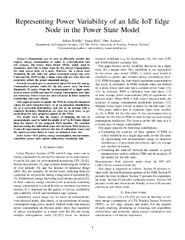Representing Power Variability of an Idle IoT Edge Node in the Power State Model
Permanent link
https://hdl.handle.net/10037/35822View/
Accepted manuscript version (PDF)
Date
2023-05-01Type
ChapterBokkapittel
Abstract
Simulations can be used to efficiently predict and explore energy consumption of nodes in cyber-physical and IoT systems. The Power State Model (PSM), widely used in simulators, uses only a single value for the energy consumption, for each power state of a node. However, for a given state (including the idle state) the actual consumed energy can vary. Consequently, PSM having a single value only per state does not accurately reflect the actual consumed energy.Previous research give us measured values for how the energy consumption actually varies for the idle power state, for three Raspberry Pi nodes. From the measurements of a single node, several traces of different sizes for energy consumption over time are extracted. These traces are also extracted in three scenarios considering cold start effects.This paper proposes to update the PSM, by using the measured values for each extracted trace: (i) as an empirical distribution; (ii) as a percentile distribution; and (iii) as an average with a standard deviation. Simulations are done for each trace, to get predictions for each proposed update of the PSM.The results show that the impact of changing the size of measurements used to build the model is 4.7 to 8.9 times higher than the impact of the proposed PSM updates. We conclude that increasing the calibration trace size increases PSM accuracy. Trade-off experiments between the size of calibration traces and the model accuracy helps to chose an informed trace size.
Publisher
IEEECitation
Tofaily S, Rais I, Anshus O: Representing Power Variability of an Idle IoT Edge Node in the Power State Model. In: Kim DI, Han Z, Niyato D, Rodrigues JJPC, Chau Y, Guo B, Dustdar S, Li M, García-Lopez, Wang X, Gandhi, Zhai. Proceedings of the iThings-GreenCom-CPSCom-SmartData-Cybermatics 2023 , 2023. IEEE (Institute of Electrical and Electronics Engineers) p. 540-546Metadata
Show full item recordCollections
Copyright 2023 The Author(s)


 English
English norsk
norsk